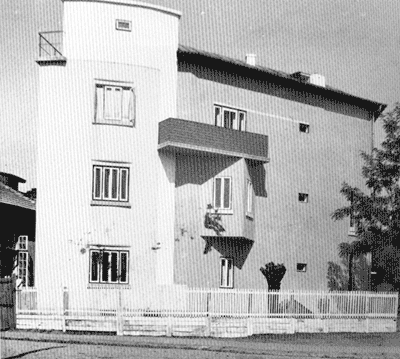
Herman Iancu building
This first example of Modern architecture in Romania is a small apartment building, built on Janco's father propriety. Its strange shape (partly due to the conditions imposed by the Municipality in view of opening a new street, partly determined by the architect's will to challenge the conservative, traditional environment) responds in the unusual forms of certain rooms. The building stands for an aesthetic exercise that contains obvious expressionistic overtones and reminds us of the plastic reliefs Janco created in Zurich starting with 1917.
Apart from the thoroughly unconventional articulation of the unusually shaped volumes and the expressive unfolding of blind surfaces, the most outstanding feature of the building appears in the chromatics of the facade, which forms a relatively autonomous element in the composition. If in certain projects of interior architecture Janco used to decompose the architectural shape by means of colour schemes, in this particular space, polychromy generates architecture. This kind of aesthetic pursuit, though recurrent in Marcel Janco's architecture, is not in the least typical for what Modernism was to become in Bucharest.
IDENTITY OF THE BUILDING/GROUP OF BUILDINGS
- current name
- variant or former name:
- address
BUILDING TYPE
- original function
- present function
- intended function
STYLISTIC AFFILIATION
AUTHOR
ORIGINS OF THE BUILDING
- data of the project
- data of the original structure
- associated persons or organitations
- building materials / techinques
- remarks
CURRENT CONDITION AND ALTERATIONS
PROTECTION STATUS
- type
- agency responsible
- summary of restoration
DESCRIPTION
EVALUATION (A,B,C,D)
- technical
- social
- aesthetic
- contextual
DOCUMENTION & REFERENCES
- publications
- location of drawings, written records, etc
- visual material provided